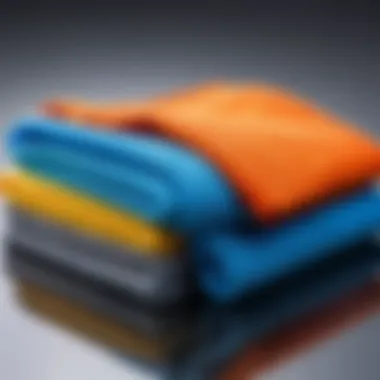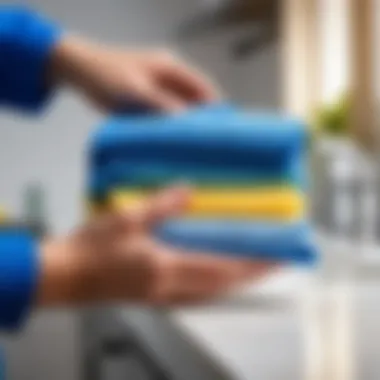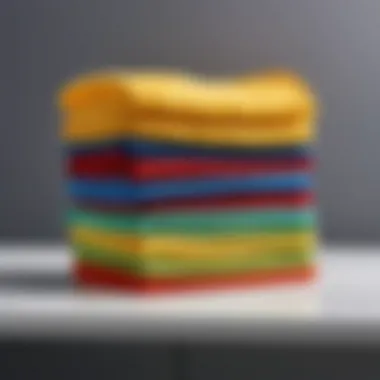Essential Guide to Choosing and Using Cleaning Cloths


Intro
Cleaning cloths are an integral part of maintaining hygiene in both personal and professional settings. Their utility ranges from wiping surfaces to polishing delicate items. This guide aims to provide a detailed overview of cleaning cloths, emphasizing various materials, their distinct applications, and practical maintenance tips. Understanding the nuances of different cloth types can significantly enhance efficiency and effectiveness in cleaning tasks.
The right cleaning cloth not only helps in achieving cleanliness but also promotes a healthier environment by reducing the spread of germs. As we explore this topic, we will cover key areas of interest, including the properties of various cleaning cloth materials, examples of their uses, and care practices that extend the lifespan of these essential tools.
This narrative caters to individuals who appreciate cleanliness and efficiency—students and young professionals, families with children, and budget-conscious shoppers. Each section will unfold with the aim of making complex information accessible, equipping readers with the knowledge to make informed choices regarding cleaning cloths.
Актуальные акции и скидки
Cleaning cloths can often be found at discounted prices, making it an excellent time for consumers to stock up. Here we will explore current offers and specific brand promotions.
Обзор текущих предложений
Retailers frequently run sales on cleaning supplies. Whether it be bulk discounts, seasonal promotions, or clearance sales, keeping abreast of these offers can yield significant savings. Not only do these discounts help reduce overall expenses, but they also encourage well-maintained environments. Check your local stores or online marketplaces to find these deals.
Специальные предложения от популярных брендов
Leading brands like Microfiber Wholesale and Scotch-Brite often have special deals. Signing up for newsletters can alert you to flash sales or limited-time offers. Shopping during major holidays can also reveal substantial discounts on cleaning cloths, making it easier to get essential supplies at economical prices.
Preface to Cleaning Cloths
In daily life, cleaning cloths have an essential role. They vary in types and materials, serving multiple purposes across different settings. Understanding their functions and the correct applications is crucial for effective cleaning. This section introduces the fundamentals of cleaning cloths, assisting readers in making informed choices and enhancing both personal and shared spaces.
Definition and Purpose
Cleaning cloths are versatile materials designed for cleaning various surfaces. They come in different compositions such as microfiber, cotton, and paper, each offering unique benefits. The primary purpose of cleaning cloths is to remove dirt, grime, and contaminants, ensuring hygiene and cleanliness.
Key Purposes Include:
- Absorption: Many cloths are designed to soak up spills efficiently.
- Scrubbing: Certain types provide a rough texture for effective cleaning of stubborn dirt.
- Polishing: Some are ideal for giving surfaces a smooth finish, especially glass and metal.
Choosing the appropriate cloth based on the task ensures that the cleaning is both effective and gentle on surfaces, avoiding scratches or damage.
Historical Context
The use of cloths for cleaning purposes traces back thousands of years. In ancient civilizations, people used natural materials like animal hides and woven fibers. As technology advanced, new materials emerged, leading to modern cleaning cloths. The introduction of synthetic fibers in the mid-20th century revolutionized the cleaning industry. Microfiber, for instance, was developed in the 1970s and quickly gained popularity due to its superior cleaning ability and efficiency.
Over time, the understanding of cleaning cloths has evolved, leading to a greater emphasis on material science and environmental considerations. Today, consumers are more informed about the benefits and disadvantages of different cloth types, leading to more sustainable choices.
Types of Cleaning Cloths
Understanding the various types of cleaning cloths available is essential for optimal cleaning results. Each type of cloth has unique properties that cater to specific tasks, making it vital to select the correct one for the job. This selection impacts not only cleaning efficiency but also costs and environmental considerations. The importance of recognizing these distinctions cannot be overlooked, as using the wrong cloth can lead to subpar results or even damage surfaces.
Microfiber Cloths
Features and Benefits
Microfiber cloths are highly regarded for their superior cleaning capabilities. Their fine fibers are designed to trap dirt and dust effectively. This characteristic makes microfiber a popular choice for many cleaning applications. Furthermore, they are often machine washable and durable, allowing for repeated use without degrading performance. The ability to clean effectively without harsh chemicals is also noteworthy, making them a safer choice for households with children or pets.
Common Uses
The versatility of microfiber cloths extends across various cleaning scenarios. They can be used on surfaces from electronics to glass and even for dusting. Their exceptional absorbency sets them apart for tasks involving spills or wet cleaning. Additionally, because they leave minimal lint behind, they are suitable for polished surfaces, ensuring a streak-free finish.
Care Instructions
Caring for microfiber cloths is straightforward, which contributes to their popularity. They should be washed separately to prevent lint from other fabrics sticking to them. It is advisable to use mild detergents and avoid fabric softeners, as these can affect the cloth's effectiveness. Regular washing ensures these cloths maintain their properties and last long, making them a cost-effective option.
Cotton Cloths
Features and Benefits
Cotton cloths have long been favored for their absorbency and softness. One of the most significant benefits of cotton is its bio-degradability; thus, they are a more environmentally friendly option compared to synthetic materials. Additionally, cotton cloths are readily available and often less expensive than alternatives, making them a preferred choice for larger scale cleaning tasks.
Common Uses


These cloths are commonly used for general household cleaning. Cotton cloths effectively soak up spills, making them ideal for kitchens and dining areas. They also work well for drying dishes or wiping surfaces. However, they may not perform as well on glass or delicate surfaces compared to microfiber cloths, mainly due to higher lint production.
Care Instructions
To maintain cotton cloths, washing them in hot water is effective for sanitizing. They can be tumble dried, but high heat may cause shrinkage over time. Given their durability, cotton cloths can be used multiple times, but they should be replaced when worn out to ensure efficiency and hygiene.
Paper Towels
Features and Benefits
Paper towels are synonymous with convenience. They are disposable, which eliminates the hassle of cleaning after every use. This is particularly advantageous in environments where sanitation is critical, such as in kitchens or during food preparation. Their absorbency means they can quickly handle spills.
Common Uses
Paper towels are primarily used for wiping up spills and cleaning surfaces. They are effective in bathrooms and kitchens due to their single-use nature and ability to prevent cross-contamination. However, they can be less efficient for tasks that require significant scrubbing, as they may disintegrate with heavy use.
Disposal Considerations
The disposal of paper towels is a significant factor. Since they are designed for one-time use, this contributes to landfill waste. Some paper towels are compostable, which can be a more eco-friendly option. Consumers should ensure they are disposing of them in a responsible manner, especially in high-volume usage scenarios.
Sponge Cloths
Features and Benefits
Sponge cloths combine the absorbency of sponges with the convenience of cloths. They can hold several times their weight in liquid while providing a scrubbing surface. This unique property makes them suitable for scrubbing tough, stuck-on messes while still being gentle on surfaces.
Common Uses
These cloths are often used in kitchens for cleaning dishes and surfaces alike. Their ability to handle both dish soap and water makes them suitable for washing various kitchen items efficiently. However, they may not replace microfiber when it comes to finer dust or delicate surfaces, where scratching is a concern.
Care Instructions
Cleaning sponge cloths typically involves rinsing them thoroughly after each use. They can be sanitized by placing them in the dishwasher or microwave. Individual care instructions may vary by brand, adding a level of flexibility to usage depending on household preferences.
Specialized Cleaning Cloths
Glass Cleaning Cloths
Glass cleaning cloths are specifically designed to tackle glass surfaces without leaving streaks or lint. Made from certain blends of materials, they optimize clarity and shine. Their usage can significantly improve the appearance of windows, mirrors, and displays—especially important in a professional setting.
Kitchen and Dish Cloths
These cloths are tailored for kitchen use, often being thicker and more durable. They absorb moisture quickly, making them suitable for drying dishes and wiping countertops. However, it is vital to differentiate them from other cloths to prevent cross-contamination. Proper management of kitchen cloths can lead to improved hygiene practices.
Selecting the Right Cleaning Cloths
Selecting the right cleaning cloths is essential in achieving effective cleaning results. The choice of cloth can greatly influence the quality of cleaning. Factors such as surface type, material composition, and cleaning methods play critical roles. Understanding these elements ensures that users can maximize hygiene in their environments.
Factors to Consider
Surface Type
Surface types vary widely, from glass to stainless steel to wood. The material of the surface dictates the type of cleaning cloth that works best. For example, microfiber cloths are excellent for glass surfaces, as they do not leave lint.
- Key Characteristic: Microfiber's ability to trap dirt and absorb moisture makes it ideal for shiny surfaces.
- Advantages: They prevent scratches and are effective in picking up dust.
- Disadvantages: Not all cloths are safe for delicate surfaces like soft woods.
Material Composition
The type of material a cleaning cloth is made of greatly impacts its effectiveness. Common materials include cotton, microfiber, and synthetic fabrics.
- Key Characteristic: Microfiber's denser weave allows it to capture particles effectively.
- Advantages: Microfiber cloths can reduce the need for cleaning chemicals.
- Disadvantages: Some people may prefer cotton for its natural feel but it’s not as effective in picking up dirt.
Cleaning Method
The cleaning method should dictate cloth selection. Different methods may require different cloths for optimal effectiveness.
- Key Characteristic: Certain techniques like wiping or scrubbing require cloths that can withstand friction.
- Advantages: Using the appropriate cloth can make a cleaning task more efficient.
- Disadvantages: Using the wrong cloth may lead to streaks or scratches on surfaces.


Environmental Impact
Considering environmental impact is increasingly important in today’s cleaning practices. Decisions between biodegradable options and choosing reusable or disposable cloths can have lasting effects.
Biodegradable Options
When discussing biodegradable options, one must evaluate the ability of a cleaning cloth to break down naturally without harming ecosystems. Options like certain cellulose sponges can be composted after use.
- Key Characteristic: Biodegradable cloths do not contribute to landfill issues.
- Advantages: They help in reducing waste.
- Disadvantages: May not always perform as well as synthetic fabrics in terms of longevity.
Reusability vs. Disposability
This factor is vital in the sustainability conversation. Reusable cloths can be washed and utilized many times, while disposable options are often convenient but costly over time.
- Key Characteristic: Reusable cloths reduce the overall environmental footprint.
- Advantages: They save money in the long run and are often more durable.
- Disadvantages: Initial cost of reusable cloths may be higher, and they require washing which can be time-consuming.
Cleaning Techniques
In the realm of cleaning, techniques play a crucial role in ensuring that the cleaning process is effective and efficient. Understanding the right methods can prevent damage to surfaces and improve overall results. It is not enough to simply use the right cloths; knowing how to utilize them properly enhances their effectiveness.
Effective Usage
Proper Techniques
Proper techniques involve specific methods of utilizing cleaning cloths for maximum performance. These include the right motions, angles, and pressure when wiping down surfaces. Applying a systematic approach, such as working from top to bottom or left to right, avoids the risk of missing spots or spreading dirt. Equally important is the technique of folding the cloth to expose a clean area for each wipe, allowing for better absorption and less residue left behind on surfaces.
One key characteristic of proper techniques is their contribution to efficiency. For example, using a gentle, circular motion can be beneficial when cleaning delicate surfaces like glass. By following recommended techniques, users can prevent streaking and ensure a sparkling finish. However, a disadvantage may arise when users apply too much pressure, which could lead to scratches, especially on sensitive materials.
Common Mistakes to Avoid
Avoiding common mistakes is vital in maintaining cleanliness and preserving the integrity of surfaces. One prevalent error is using a damp cloth on surfaces that should be dry, potentially leading to water damage or streaks. Another mistake is using the same area of the cloth repeatedly, which can simply redistribute dirt instead of removing it.
The key characteristic of recognizing common mistakes is that it helps users refine their approach to cleaning. By being aware of these pitfalls, individuals can foster better cleaning habits. However, new users might find it challenging to adapt their techniques quickly. This steep learning curve can result in frustration, underscoring the importance of continuous practice and mindfulness when cleaning.
Combining with Cleaning Solutions
The combination of cleaning cloths with appropriate cleaning solutions is of great significance. The choice of cleaner can enhance the effectiveness of the cloths, leading to better cleanliness and hygiene. Different materials require specific cleaning solutions to avoid causing harm or diminishing efficacy.
Choosing the Right Cleaner
Choosing the right cleaner is pivotal to achieving desired cleaning results. For instance, an all-purpose cleaner may be suitable for many surfaces, but specialized cleaners can yield better results on specific materials like stainless steel or glass. The key characteristic of selecting proper cleaners is their compatibility with both the cloth and the surface being cleaned. This compatibility can maximize efficiency and ensure that the cleaning process does not inadvertently damage surfaces.
The unique feature of choosing the right cleaner is that it not only affects how well the surface is cleaned but also impacts the longevity of both the cloth and the surface. However, misreading product labels or using incorrect cleaners might result in unwanted reactions, like discoloration or residue buildup.
Application Methods
Application methods refer to how cleaning solutions are applied to surfaces, influencing the overall cleaning process. Spray, pour, or dampen are common methods used. For instance, using a spray allows for controlled application, particularly useful for stubborn stains. This careful application can prevent over-saturation of cleaning solutions that might cause damage.
The key characteristic of effective application methods is their ability to target cleaning efforts. Applying the right amount in the correct manner can greatly improve cleaning results. However, a downside is that inexperienced users may not accurately gauge the amount needed, leading to wastage of both cleaner and time.
By mastering proper cleaning techniques and suitable cleaning solutions, users can elevate their cleaning practices significantly. This improvement not only enhances immediate cleanliness but also contributes to long-lasting maintenance of environments.
Maintenance of Cleaning Cloths
The maintenance of cleaning cloths is a critical aspect of ensuring their longevity and effectiveness. Proper care not only helps in extending the life of the cloth but also ensures that the cleaning tasks are performed efficiently. This section outlines essential washing recommendations and storage solutions that contribute to cleaner homes and workplaces.
Washing Recommendations
Machine Washing
Machine washing is a common choice for maintaining cleaning cloths. This method allows for thorough cleaning with minimal effort. One significant characteristic of machine washing is the ability to manage multiple cloths at once. This is especially beneficial for busy households or establishments where downtime needs to be minimized. The unique feature of machine washing includes the consistent cycle of agitation and rinsing, which removes dirt and impurities effectively. However, it is important to select the appropriate wash setting, as some cloths may require a gentle cycle to prevent damage.
Advantages of machine washing include time efficiency and convenience, while its disadvantages might be the risk of fabric wear if not done properly. For instance, high heat can degrade some materials, affecting their cleaning performance over time.
Hand Washing


Hand washing offers a gentler alternative for cleaning cloths, especially those made from delicate materials. This method gives the user more control over the washing process, ensuring that each cloth receives the necessary attention. A key characteristic of hand washing is its customization; individuals can choose the soap and temperature, which can be beneficial for specific types of stains or soils.
The unique feature of hand washing is its ability to preserve the fabric integrity, making it an ideal choice for specialized cloths that may not withstand machine cycles. However, it requires more time and effort, which could be a disadvantage for those with a busy schedule.
Storage Solutions
Organization Tips
Organizing cleaning cloths is essential for maintaining an efficient cleaning routine. Proper organization can dramatically improve accessibility. A key aspect of organization is the separation of cloths based on their use. Using bins or designated areas for specific types—like kitchen, bathroom, or general cleaning—can enhance cleanliness and the overall effectiveness of the cleaning process.
The unique feature of having organized storage is that it prevents wasting time searching for the right cloth when needed. This practical approach not only saves time but can also reduce frustration, contributing to a more enjoyable cleaning experience.
Preventing Contamination
Preventing contamination of cleaning cloths is vital for ensuring hygiene and safety. One important characteristic is to ensure that cloths used in specific areas, like kitchens, are kept separate from those used in bathrooms or for dusting. This consideration minimizes the risk of cross-contamination.
A unique aspect of this practice is maintaining separate storage for different functions. Effective prevention measures include labeling and compartmentalization, allowing users to easily locate the right cleaning cloths without mixing them up. While setting up these systems may take time initially, the long-term benefits for hygiene are significant.
Regular maintenance of cleaning cloths through effective washing and secure storage is essential for optimal cleaning results and longevity of your supplies.
Cost Considerations
Understanding cost considerations is essential for anyone looking to maintain a clean environment without overspending. Cleaning supplies can represent a significant portion of household or business expenses. Therefore, making informed decisions about the types of cleaning cloths and their associated costs can lead to more effective budgeting and overall savings in the long run. This section outlines budgeting strategies for cleaning supplies and assesses their value.
Budgeting for Cleaning Supplies
When planning a budget for cleaning supplies, it is vital to consider several factors. First, identifying the specific needs for cleaning in a household or a workplace can help prioritize which types of cloths to purchase. This involves understanding the areas that require frequent cleaning and the type of messes encountered.
A few tips for budgeting include:
- Inventory Needs: Assess what cleaning tasks are performed regularly and what cloths are needed.
- Compare Prices: Look at different stores and online marketplaces to find the best prices on cleaning cloths.
- Bulk Buying: Purchasing cloths in bulk can often lead to discounts, providing more value for larger families or businesses.
By effectively budgeting, consumers can allocate their finances to ensure they acquire the right cleaning cloths without unnecessary expenditure.
Value Assessment
Evaluating the value of cleaning cloths encompasses understanding both the cost and performance aspects. Two key points to consider are the cost versus performance balance and the potential for long-term savings.
Cost vs. Performance
Cost versus performance is a crucial consideration when evaluating cleaning cloths. The effectiveness of a cloth in delivering results can outweigh its initial expense. For example, microfiber cloths may come with a higher upfront cost compared to cotton cloths. However, they often provide superior cleaning capabilities. This superior performance may lead to less product usage and fewer purchases over time.
Key Characteristics of Cost vs. Performance:
- Durability: Higher-cost options tend to be more durable, leading to extended use.
- Efficiency: Better performance often results in quicker cleaning, which is valuable in busy environments.
This comparison helps buyers understand that investing in higher-quality cloths can yield better value in performance and reduced frequency of replacement.
Long-Term Savings
Analyzing long-term savings reflects on the total cost of ownership associated with cleaning cloths. While a lower initial investment may seem practical, the frequency of replacement can inflate overall expenses.
Key Characteristics of Long-Term Savings:
- Reusable Options: Cloths that are durable and reusable reduce the need for frequent purchases, thereby providing savings in the long term.
- Reduced Wastage: Opting for cloths designed for multiple washes minimizes waste, benefiting both the environment and cost consideration.
Investing in high-performance cleaning cloths not only enhances cleaning efficiency but also fosters greater financial prudence over time.
Ending
In wrapping up this exploration on cleaning cloths, it becomes clear that understanding their varied applications is paramount. Cleaning cloths are not merely tools; they serve as essential components in maintaining hygiene and cleanliness across diverse environments. This article has addressed not only the types of cleaning cloths but also their specific uses, care, and maintenance. The takeaway here is that selecting the appropriate cleaning cloth can significantly influence cleaning efficiency and effectiveness.
Summary of Key Points
- Types of Cleaning Cloths: Different materials offer unique benefits. Microfiber cloths are versatile and effective for a range of surfaces. Cotton cloths are absorbent but may not be as durable. Specialized cloths cater to specific cleaning challenges, enhancing performance.
- Selecting the Right Cloth: Consider surface type, material composition, and cleaning method. This selection process impacts both the results and the longevity of the cleaning cloths used.
- Cleaning Techniques: Proper usage techniques can dramatically improve cleaning outcomes. Avoid common mistakes to ensure both surface safety and cloth longevity.
- Maintenance Practices: Regular washing and proper storage are vital. This not only prolongs the life of the cloths but also maintains their cleaning capabilities.
- Cost Considerations: Evaluating the cost versus performance is essential when investing in cleaning supplies. Choosing high-quality cloths can result in long-term savings through durability and reusability.
Future Trends in Cleaning Cloth Technology
The future of cleaning cloths is promising, with innovations focusing on durability and sustainability. Here are some trends that might influence the market:
- Sustainable Materials: The demand for eco-friendly materials is rising. Manufacturers are exploring options like recycled fibers and biodegradable cloths to reduce environmental impact.
- Enhanced Performance: Advancements in textile technology could lead to cloths with improved cleaning mechanics, allowing them to attract more dirt and bacteria effectively.
- Smart Technology Integration: Future cloths may include technology that enhances cleaning efficiency, such as embedded antibacterial properties or color-changing indicators to show when they need washing.
- Customization: Consumers may see more options for tailored cloths designed for specific tasks or surface needs, further emphasizing the importance of selecting the right tools for cleaning.
Overall, the future will likely focus on merging functionality with sustainability, reflecting broader consumer concerns and technological advancements.



